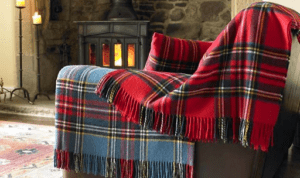Tartan, with its rich tapestry of colors and intricate patterns, stands as an enduring symbol of Scottish heritage and tradition. Among the vast array of tartans, Cyllene Tartan emerges as a unique and revered pattern, holding a special place in Scotland’s illustrious tartan legacy. Originating from the ancient traditions of Scotland, Cyllene Tartan encapsulates the spirit of the Highlands, weaving together tales of ancient clans and rugged landscapes. In this article, we delve into the captivating history, cultural significance, and distinctive features of Cyllene Tartan, exploring why it continues to captivate the hearts and imaginations of Scots and enthusiasts worldwide.
Origin and History
The history of Cyllene Tartan traces back to the ancient traditions of Scotland. Its exact origins are shrouded in mystery, with tales and legends contributing to its mystique. However, historians suggest that Cyllene Tartan emerged during a period of cultural flourishing in Scotland, where tartans became synonymous with clan identity and regional affiliation. Cyllene Tartan has evolved over centuries, adapting to changing societal norms and fashion trends. From its humble beginnings as a utilitarian garment worn by Highlanders to its modern status as a symbol of Scottish pride, Cyllene Tartan has withstood the test of time, retaining its significance in the hearts of Scots around the world.
The Cultural Significance of Tartan
Tartan: A Symbol of Scottish Heritage
Tartan is more than just a fabric; it is a symbol of Scottish identity and pride. The intricate patterns and vibrant colors of tartan are deeply ingrained in the cultural fabric of Scotland, representing the country’s history, landscape, and traditions. Tartan has been woven into the very fabric of Scottish society for centuries. Its origins can be traced back to the Gaelic-speaking peoples of ancient Scotland, who used natural dyes to create colorful patterns on woven cloth. Over time, tartan became synonymous with clan identity, with each distinct pattern representing a specific lineage or family group. The wearing of tartan was once banned following the Jacobite uprisings of the 18th century, but it experienced a resurgence in the 19th century during the Romantic revival of Scottish culture. Since then, tartan has become an enduring symbol of Scottish heritage, worn proudly by Scots and enthusiasts around the world.
Importance in Scottish Culture
Tartan plays a central role in Scottish cultural celebrations and events. From traditional Highland gatherings such as Highland Games to formal occasions like weddings and graduations, tartan is worn with pride to showcase Scottish identity and heritage. The distinctive patterns of tartan are also reflected in Scottish art, music, and literature, serving as a source of inspiration for artists and creatives. Tartan has become synonymous with the rugged beauty of the Scottish landscape, evoking images of rolling hills, ancient castles, and mist-shrouded glens.
Exploring Cyllene Tartan
Cyllene Tartan: An Overview
Cyllene Tartan is distinguished by its intricate patterns and vibrant colors, making it a sought-after design among tartan enthusiasts worldwide. Its unique combination of hues and motifs sets it apart from other tartans, capturing the imagination of those who admire its beauty. Cyllene Tartan is named after the mythical mountain of Cyllene, which is said to be the birthplace of Hermes in Greek mythology. This connection to ancient lore adds to the allure of Cyllene Tartan, imbuing it with a sense of mysticism and wonder. What sets Cyllene Tartan apart is its bold color palette and intricate weaving technique. The pattern typically features a combination of earthy tones such as greens, browns, and blues, interspersed with vibrant accents of red, yellow, and orange. The result is a visually striking design that commands attention and admiration.
Origins and Development
The origins of Cyllene Tartan can be traced back to the creative minds of Scottish weavers who sought to capture the essence of Scotland’s rugged landscapes and natural beauty. Drawing inspiration from the rolling hills, misty lochs, and ancient forests of the Highlands, these artisans crafted a design that reflects the spirit of Scotland. Over time, Cyllene Tartan has undergone various iterations and adaptations, reflecting changes in fashion and design trends. However, its core elements have remained intact, ensuring that it remains true to its Scottish roots while also appealing to modern tastes.
Design and Patterns
Patterns and Color Scheme
The design of Cyllene Tartan is characterized by its intricate patterns and vibrant color scheme, which are meticulously woven into the fabric to create a visually stunning effect. Cyllene Tartan features a combination of geometric patterns and Celtic motifs, which are woven together to form a cohesive design. These patterns often incorporate symbols of nature, such as thistles, stags, and Celtic knots, which hold special significance in Scottish culture.
Symbolism Behind Colors
The colors used in Cyllene Tartan hold symbolic meaning, with each hue representing different aspects of Scottish heritage and tradition. For example, shades of green may symbolize the lush landscapes of Scotland, while hues of blue may evoke images of the country’s shimmering lochs and rivers. The vibrant accents of red, yellow, and orange add warmth and depth to the design, creating a sense of energy and vitality. Together, these colors come together to form a harmonious palette that reflects the spirit of Scotland.
Influence of Nature and Geography
The design of Cyllene Tartan is heavily influenced by the natural beauty of Scotland’s landscape, with motifs and patterns inspired by the country’s rugged terrain and breathtaking scenery. The rolling hills, misty moors, and dramatic coastlines of Scotland serve as a constant source of inspiration for tartan designers. The rich tapestry of colors and textures found in the Scottish countryside is reflected in the intricate patterns and motifs of Cyllene Tartan, creating a design that is both timeless and evocative. Cyllene Tartan often incorporates symbols of nature, such as thistles, heather, and Scottish wildlife, which are woven into the fabric to create a sense of connection to the land. These natural elements not only add visual interest to the design but also imbue it with a deeper meaning, reflecting Scotland’s close relationship with the natural world.
Cyllene Tartan Today
Modern Applications
In the modern era, Cyllene Tartan continues to captivate audiences with its timeless beauty and versatility. While traditionally worn as kilts and other traditional garments, Cyllene Tartan has found new life in contemporary fashion and design. Today, Cyllene Tartan can be found adorning a wide range of products, from clothing and accessories to home decor and furnishings. Its bold patterns and vibrant colors make it a popular choice for those looking to add a touch of Scottish flair to their wardrobe or living space.
Fashion and Design
Designers around the world have embraced Cyllene Tartan as a symbol of heritage and tradition, incorporating it into their collections in innovative and unexpected ways. From high-end fashion houses to independent designers, Cyllene Tartan has been reimagined and reinvented, ensuring its relevance in today’s fashion landscape. Whether showcased on the runway or worn on the streets, Cyllene Tartan continues to make a statement, bridging the gap between past and present. In recent years, there has been a concerted effort to revive and preserve traditional tartan designs, including Cyllene Tartan. Organizations dedicated to Scottish heritage and textile preservation have worked tirelessly to catalog and document historic tartan patterns, ensuring that they are not lost to time.
Role of Organizations and Designers
Leading the charge in tartan preservation are organizations such as the Scottish Tartans Authority and the Scottish Register of Tartans, which oversee the registration and regulation of tartan designs. These organizations work closely with designers, weavers, and historians to research and authenticate traditional tartans, ensuring their continued use and recognition. Designers and textile enthusiasts have also played a crucial role in the revival of Cyllene Tartan, breathing new life into age-old patterns and motifs. By incorporating Cyllene Tartan into their collections and promoting its cultural significance, these individuals have helped to ensure that this iconic design remains relevant for generations to come.
The Tartans of Scotland
Originating in the Highlands, these distinctively woven fabrics were initially used to signify different clans and regions, each boasting its unique combination of colors and designs. The tartans of Scotland are more than mere patterns; they are a profound emblem of Scottish identity, encapsulating the essence of the nation’s heritage and history. Over centuries, tartans have evolved from their utilitarian origins into powerful symbols of pride and tradition, often worn during cultural festivals, weddings, and national celebrations. The vibrant hues and intricate designs of the tartans of Scotland not only celebrate the country’s rich natural landscapes and historical narratives but also serve as a timeless connection to its storied past.
Cyllene Tartan in Popular Culture
Representation in Media and Arts
Cyllene Tartan has made its mark on popular culture, appearing in literature, film, and art as a symbol of Scottish identity and heritage. Its distinctive patterns and vibrant colors have captured the imagination of artists and filmmakers, who have incorporated Cyllene Tartan into their works to evoke a sense of Scottishness. From the pages of classic novels to the silver screen, Cyllene Tartan has been featured prominently in various forms of media. Whether depicted as the attire of rugged Highland warriors or the backdrop for romantic encounters, Cyllene Tartan has become synonymous with the timeless allure of Scotland. In addition to its appearances in literature and film, Cyllene Tartan has also left its mark on the world of fashion and design. Its bold patterns and vibrant colors have been embraced by celebrities and influencers, who have incorporated Cyllene Tartan into their personal style, further solidifying its place in popular culture.
Global Recognition
Cyllene Tartan Beyond Scotland
While Cyllene Tartan is deeply rooted in Scottish culture, its appeal extends far beyond the borders of Scotland. From fashion runways in Paris to boutique shops in Tokyo, Cyllene Tartan has found fans around the globe who appreciate its timeless beauty and cultural significance. The universal appeal of Cyllene Tartan lies in its ability to transcend geographical and cultural boundaries. Whether worn as a symbol of Scottish pride or simply appreciated for its aesthetic appeal, Cyllene Tartan serves as a reminder of Scotland’s rich heritage and storied past.
Conclusion
In conclusion, Cyllene Tartan holds a special place in Scotland’s tartan legacy, representing the country’s rich history, culture, and tradition. From its ancient origins to its modern-day revival, Cyllene Tartan continues to captivate audiences with its timeless beauty and symbolic significance. As Scotland’s national fabric, Cyllene Tartan serves as a proud reminder of the country’s enduring spirit and cultural heritage.
FAQs About Cyllene Tartan
- What makes Cyllene Tartan unique compared to other tartans?
Cyllene Tartan is unique due to its distinctive patterns and vibrant color scheme, which set it apart from other tartans.
- Are there specific rules for wearing Cyllene Tartan?
While there are no strict rules for wearing Cyllene Tartan, it is often worn to special events or occasions as a symbol of Scottish pride and heritage.
- How can one distinguish Cyllene Tartan from other tartans?
Cyllene Tartan can be distinguished by its unique combination of colors and patterns, which are unlike those found in other tartans.
- Is Cyllene Tartan only worn on special occasions?
While Cyllene Tartan is often worn to special events, it can also be worn casually as a fashion statement or to showcase Scottish heritage.
- Are there any famous figures associated with Cyllene Tartan?
While there are no specific famous figures associated with Cyllene Tartan, it has been worn by numerous Scottish celebrities and dignitaries throughout history.









